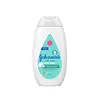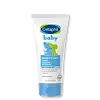What's inside
What's inside
 Key Ingredients
Key Ingredients

 Benefits
Benefits

 Concerns
Concerns

 Ingredients Side-by-side
Ingredients Side-by-side

Water
Skin ConditioningIsopropyl Palmitate
EmollientGlycerin
HumectantCocoglycerides
EmollientCetyl Alcohol
EmollientPEG-100 Stearate
Dimethicone
EmollientPhenoxyethanol
PreservativeCarbomer
Emulsion StabilisingGlyceryl Stearate
EmollientParfum
MaskingP-Anisic Acid
MaskingSodium Hydroxide
BufferingEthylhexylglycerin
Skin ConditioningDisodium EDTA
Panthenol
Skin ConditioningTocopheryl Acetate
AntioxidantXanthan Gum
EmulsifyingSodium Ascorbyl Phosphate
AntioxidantMilk Protein
Skin ConditioningHydrolyzed Rice Bran Protein
Skin ConditioningMagnesium Aspartate
Skin ConditioningZinc Gluconate
Skin ConditioningCopper Gluconate
Skin ConditioningWater, Isopropyl Palmitate, Glycerin, Cocoglycerides, Cetyl Alcohol, PEG-100 Stearate, Dimethicone, Phenoxyethanol, Carbomer, Glyceryl Stearate, Parfum, P-Anisic Acid, Sodium Hydroxide, Ethylhexylglycerin, Disodium EDTA, Panthenol, Tocopheryl Acetate, Xanthan Gum, Sodium Ascorbyl Phosphate, Milk Protein, Hydrolyzed Rice Bran Protein, Magnesium Aspartate, Zinc Gluconate, Copper Gluconate
Allantoin 0.5%
Skin ConditioningButyrospermum Parkii Oil
EmollientCalendula Officinalis Flower Extract
MaskingCaprylyl/Capryl Glucoside
CleansingCaprylyl Glycol
EmollientCitric Acid
BufferingGlycerin
HumectantGlycine Soja Oil
EmollientHelianthus Annuus Seed Oil
EmollientMethylpropanediol
SolventPanthenol
Skin ConditioningPantolactone
HumectantPhenoxyethanol
PreservativePolyisobutene
Sodium Acrylate/Sodium Acryloyldimethyl Taurate Copolymer
Emulsion StabilisingSorbitan Oleate
EmulsifyingTocopherol
AntioxidantWater
Skin ConditioningAllantoin 0.5%, Butyrospermum Parkii Oil, Calendula Officinalis Flower Extract, Caprylyl/Capryl Glucoside, Caprylyl Glycol, Citric Acid, Glycerin, Glycine Soja Oil, Helianthus Annuus Seed Oil, Methylpropanediol, Panthenol, Pantolactone, Phenoxyethanol, Polyisobutene, Sodium Acrylate/Sodium Acryloyldimethyl Taurate Copolymer, Sorbitan Oleate, Tocopherol, Water
Ingredients Explained
These ingredients are found in both products.
Ingredients higher up in an ingredient list are typically present in a larger amount.
Glycerin is already naturally found in your skin. It helps moisturize and protect your skin.
A study from 2016 found glycerin to be more effective as a humectant than AHAs and hyaluronic acid.
As a humectant, it helps the skin stay hydrated by pulling moisture to your skin. The low molecular weight of glycerin allows it to pull moisture into the deeper layers of your skin.
Hydrated skin improves your skin barrier; Your skin barrier helps protect against irritants and bacteria.
Glycerin has also been found to have antimicrobial and antiviral properties. Due to these properties, glycerin is often used in wound and burn treatments.
In cosmetics, glycerin is usually derived from plants such as soybean or palm. However, it can also be sourced from animals, such as tallow or animal fat.
This ingredient is organic, colorless, odorless, and non-toxic.
Glycerin is the name for this ingredient in American English. British English uses Glycerol/Glycerine.
Learn more about GlycerinPanthenol is a common ingredient that helps hydrate and soothe the skin. It is found naturally in our skin and hair.
There are two forms of panthenol: D and L.
D-panthenol is also known as dexpanthenol. Most cosmetics use dexpanthenol or a mixture of D and L-panthenol.
Panthenol is famous due to its ability to go deeper into the skin's layers. Using this ingredient has numerous pros (and no cons):
Like hyaluronic acid, panthenol is a humectant. Humectants are able to bind and hold large amounts of water to keep skin hydrated.
This ingredient works well for wound healing. It works by increasing tissue in the wound and helps close open wounds.
Once oxidized, panthenol converts to pantothenic acid. Panthothenic acid is found in all living cells.
This ingredient is also referred to as pro-vitamin B5.
Learn more about PanthenolPhenoxyethanol is a preservative that has germicide, antimicrobial, and aromatic properties. Studies show that phenoxyethanol can prevent microbial growth. By itself, it has a scent that is similar to that of a rose.
It's often used in formulations along with Caprylyl Glycol to preserve the shelf life of products.
Water. It's the most common cosmetic ingredient of all. You'll usually see it at the top of ingredient lists, meaning that it makes up the largest part of the product.
So why is it so popular? Water most often acts as a solvent - this means that it helps dissolve other ingredients into the formulation.
You'll also recognize water as that liquid we all need to stay alive. If you see this, drink a glass of water. Stay hydrated!
Learn more about Water